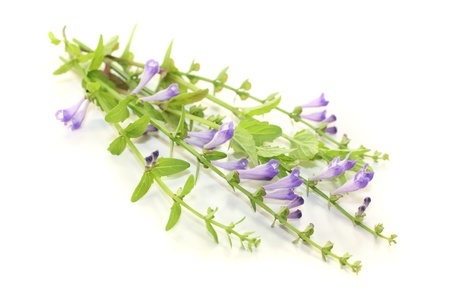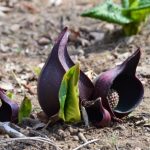
Certain Skullcap or Scutellaria plant species offer the medical world important bioactives especially for reducing anxiety.
The key components are baicalein, baicalin and wogonin which are extracted from a number of species in the genus including Scutellaria rivularis, S. larterifolia and especially S. baicalensis Georgi in particular. These active flavones are part of the Chinese herbal medicine called Huang-Qin.
Biochemically, the components inhibit xanthine oxidase which is therapeutically important for treating both tumours, Parkinson’s Disease and hepatitis. One study on antioxidant activity looked at both XO inhibition and protection of cytochrome c (Shieh et al., 2000).
Huang-Qin is claimed to have an Anti-allergenic effect. An alcoholic extract from Scutellaria root inhibits acute asthma attack and allergenic eczema.
Baicalin And Baicalein
Baicalin is a flavonoid, a flavone glycoside extracted from the roots, mainly of Scutellaria baicalensis Georgi. Baicalein is the same component but with the glycoside moiety removed. It is usually offered over the counter as an 85 to 95 percent pure concoction. It is used in Chinese herbal medicine to treat mainly inflammatory conditions such as upper respiratory tract infection and gastroenteritis.
Baicalin is stated to inhibit the permeability of capillaries and act as an a neurogenic agent and is capable of reducing anaphylaxis effects. The mode of action of both these components is by binding to the benzodiazepine receptor of the GABAA receptor complex (Hui et al., 2000; Wang et al., 2002) which in part explains their activity in reducing anxiety.
Baicalin is claimed to inhibit super antigen-induced inflammatory cytokines and chemokines. A number of other cell studies have associated it with inhibiting cancer cell proliferation, causing cancer cell death (apoptosis), protecting bone marrow cells, promoting haemopoiesis and protecting stomach cells from adverse chemotherapy. The evidence for this continues to develop and at some point should lead to specific claims.
Wogonin
Wogonin is the O-methylated flavone and its glycosides are the wogonosides. A glucuronide called oroxindin was isolated from the plant Oroxylum indicum (Ramachandran and Joshi**) and is the active ingredient in Sho-Saiko-To which is a Japanese herbal medicine. Like baicalein and baicalin, wogonin was found to have anxiolytic properties in a mouse study at doses from 7.5 to 30 mg/kg (Hui et al., 2002). It could rival benzodiazepines because it does not have sedative or muscle relaxant properties. In vitro studies indicated that pharmacologically, wogonin had anti-cancer properties as well as being an anticonvulsant (Park et al., 2007). It is thought to act as a positive allosteric modulator of the benzodiazepine site of the GABAA receptor (Park et al., 2007).
One of the issues to be resolved with studies using Scutellaria extracts is the quality of the active ingredients in the various trials that have shown some evidence to date.
References
Gao, J., Morgan, W.A., Sanchez-Medina, A., Corcoran, O. (2011). The ethanol extract of Scutellaria baicalensis and the active compounds induce cell cycle arrest and apoptosis including upregulation of p53 and Bax in human lung cancer cells. Toxicol. Appl. Pharmacol. 254 (3) pp. 221–8.
Hui, K.M., Huen, M.S., Wang, H.Y., Zheng, H., Sigel, E., Baur, R. et al. (2002). Anxiolytic effect of wogonin, a benzodiazepine receptor ligand isolated from Scutellaria baicalensis Georgi. Biochem. Pharmacol. 64 (9) pp.1415–24.
Hui, K.M., Wang, X.H., Xue, H. (2000). Interaction of flavones from the roots of Scutellaria baicalensis with the benzodiazepine site. Planta Med. 66 (1) pp. 91–3. PMID: 10705749. doi: 10.1055/s-0029-1243121
Lin, C.C., Kuo, C.L., Lee, M.H., Lai, K.C., Lin, J.P., Yang, J.S., Yu, C.S., Lu, C.C., Chiang, J.H., Chueh, F.S., Chung, J.G. (2011). Wogonin triggers apoptosis in human osteosarcoma U-2 OS cells through the endoplasmic reticulum stress, mitochondrial dysfunction and caspase-3-dependent signaling pathways. Int J Oncol 39 (1) pp. 217–224.
Ramachandran Nair, A.G., Joshi, B.S. (****) Oroxindin—A new flavone glucuronide from Oroxylum indicum.
Park, H.G., Yoon, S.Y., Choi, J.Y., Lee, G.S., Choi, J.H., Shin, C.Y. et al. (2007). Anticonvulsant effect of wogonin isolated from Scutellaria baicalensis. Eur. J. Pharmacol. 574 (2-3) pp. 112–9.
Shieh, D. E., Liu, L. T., & Lin, C. C. (1999). Antioxidant and free radical scavenging effects of baicalein, baicalin and wogonin. Anticancer research, 20(5A), pp. 2861-2865
Wang, H., Hui, K.M., Xu, S., Chen, Y., Wong, J.T., Xue, H. (2002). Two flavones from Scutellaria baicalensis Georgi and their binding affinities to the benzodiazepine site of the GABAA receptor complex. Pharmazie. 57 (12) pp. 857–8. PMID 12561253


Leave a Reply